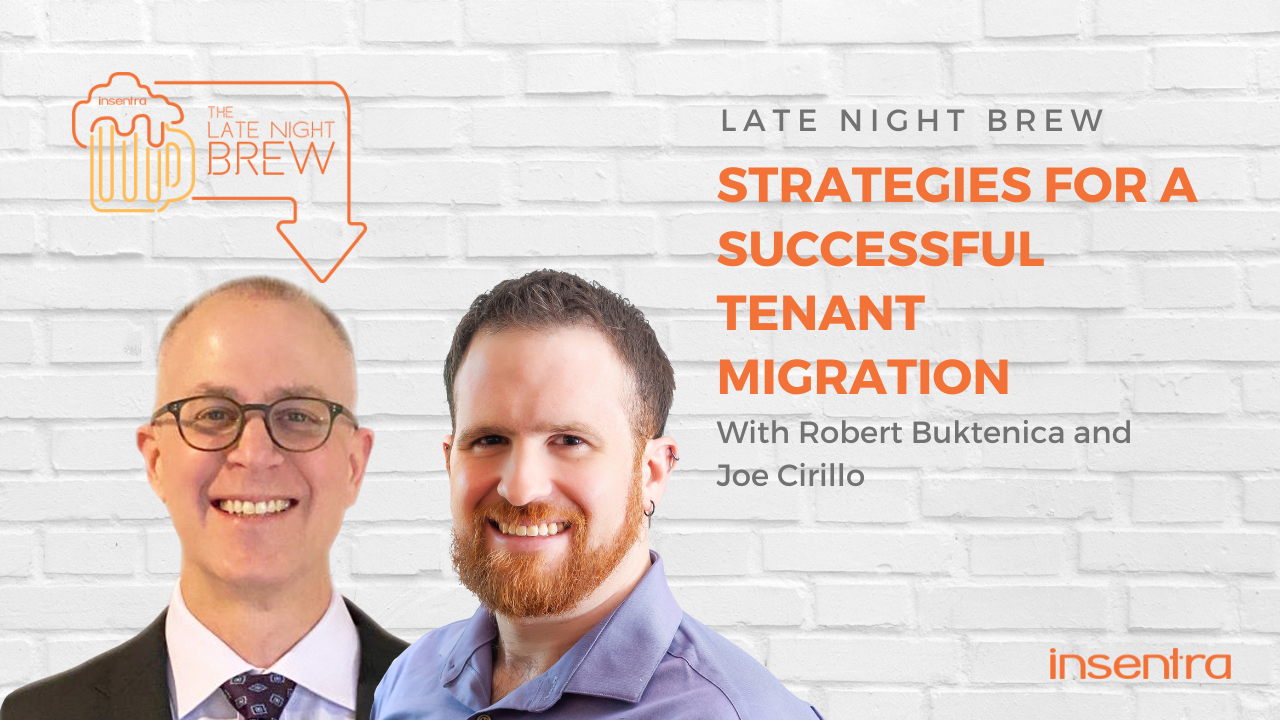We’re down to the final episode of Late Night Brew: Tenant-to-Tenant Migration! At this point, you’ve probably already checked and double-checked your migration approach, pre-staging plan and communication plan.
Now, the next step is to ensure the success of your tenant migration. But how do you do that? Robert Buktenica and Joe Cirillo explore strategies, and even the order of precedence, when migrating workloads from one tenant to another.
You know the drill—grab a drink and join this insightful discussion!
TIMESTAMP
00:07 – Introduction
00:40 – The Brew
01:28 – How do you ensure the migration goes well?
06:18 – Is there a specific order when migrating workloads to a new tenant?
TRANSCRIPT
Introduction
Robert Buktenica: Hello everyone, and welcome to another episode of the Late Night Brew, where we talk the brews first and then we get around to what we’re supposed to do after. Joining me for the final episode in this series, Joe. Thank you, Sir, as always.
Joe Cirillo: Absolutely wonderful to be here.
The Brew
Robert: Before we dive into talking about the performance and order of importance, I guess you could call it, for the migration, what brew are you having with me?
Joe: Well, you know me, I’m usually going pretty simple. Today, it is literally just, let’s see if we can see it, bottle of Sprite.
Robert: Fair. It’s starting to warm up, so I’ll call it in the interest of hydration.
Joe: That’s right.
Robert: I have got a Belgium beer, actually, St. Bernardus Wit. It’s your classic white ale. It’s good stuff and I call it the all-season. You know, a good wheat works all the way around.
Joe: Yep, excellent. I bet it’s pretty good.
How do you ensure the migration goes well?
Robert: Yeah, it’s quite enjoyable. Now, diving right in to minimise the suspense, what are some strategies to ensure that, you know, the performance, the migration as a whole goes well?
Joe: Yeah, so on the email front, Microsoft does allow you to raise or basically eliminate the throttling thresholds from an email perspective, but it’s only on email.
When you’re trying to do the other workloads like Teams, SharePoint, OneDrive, which are all hitting the SharePoint API, that’s where you have to get real creative. But even for email itself, if we go back to messaging, you know, if you have small customers of less than, say, 500 users, not a big deal, you might be able to throw all your mailboxes in one batch and just run them.
Robert: Right.
Joe: But for larger customers, they really need to think about splitting up the batches and staggering them. Most of the software vendors have recommendations around how many mailboxes, or SharePoint sites and so forth, to sync at one time. And it’s best to follow those limits and then stagger the batches as well, usually within 20 to 30 minutes.
Once a batch starts actually processing and getting up to speed, then you can sort of kick off the next one without interrupting what’s already occurring. So that’s definitely a strategy from an email perspective.
SharePoint, Teams and OneDrives — it gets much more complex because they’re all competing for that API and Microsoft heavily throttles that API, specifically during workdays because everybody’s using Teams and so forth.
So, you have to get very creative. You really want to break down order of precedence as far as priorities, you know, maybe what SharePoint site should go first versus last. Which team should go first or in users as well?
Robert: What are users actively needing? I always like to think of it of, you know, if things went wrong, what are the couple of sites or the most important sites that everything else can fall off a cliff and be handled? But these are your priority objectives, right? These are our lifeblood.
Joe: Yeah, absolutely. I mean, leading up to the migration, of course, you’re pre-staging data. But you still, even though everything’s pre-staged, you can’t take, you know, 20,000 objects all over at once. It’s just not going to happen.
So you really have to strategically plan out. If you’re doing, let’s say, a weekend cutover, you have to really strategically plan out over the course of that weekend what goes when and what order and so forth and just manage that. And set expectations with the end users to say, you know, not all of the data will potentially be there on Monday morning, but we’ll have the most critical data.
For instance, even like a mailbox, your inbox and all of your more recent items will be there. But maybe you won’t have your dumpster, your recoverable items available, right? Because usually the dumpster could be very big. It’s one of the last things we process from an email perspective or an archive mailbox as well. That’s usually, again, one of the last things we process.
As long as the user has their current mail that they’re operating in, that’s the most critical piece for them. Same thing with OneDrive, right? OneDrive is usually the next workload or at least the first workload to go on a SharePoint site and then you start staggering in the sites and Teams and so forth. But you still have to, again, get very strategic with all of that.
Robert: Yeah. And I’ll actually challenge you because you said it in passing and an incredibly important strategy is that pre-staging. I’d say that’s strategy number one or two outside of good planning, like you say.
Getting that, hey, we’re going to, in the month, let’s say, leading up to cut over, we’re going to have that running in the background. We’re going to be pulling that old data and seeding the older, yeah, this hasn’t been used in six months, so let’s pull that in. And then it’s only six months’ worth of mail or documents that we’re moving on the cut over.
So it might just be, we’re so used to thinking like that, but I want to tell it, hey, that’s an important strategy right there.
Joe: Yeah. It’s not horribly obvious, but yeah, usually we’ll start with when you first kick off that sync, we’ll go with anything older than 60 days old. But then as we get closer to migration, we might bring it up to 30 days and then maybe a week out from migration, bring it up to like, say, 15 days or less. So that then come cut over, you’re only migrating, let’s say, less than maybe 10 days of mail or something like that. Yeah.
Is there a specific order when migrating workloads to a new tenant?
Robert: You alluded to it a little bit, so I wanted to get a quick clarity of when you’re looking at everything that we have to migrate from a tenant, what’s the order of, is it mail, OneDrive, Teams, SharePoint? Is it mail, Teams, OneDrive, SharePoint? Or even is there an order? Or is it every customer has their own unique requirement?
Joe: The top priority is always end-user-specific. So you can run the email and the OneDrive workloads at the exact same time, because there’s no conflict there from a platform perspective.
Robert: API, yeah.
Joe: Yeah. So you say Friday night, okay, we’re going to kick off the final migration of all the users’ mailboxes and all the users’ OneDrive. Boom. That completes, let’s say now it’s Saturday morning, that completes.
Then you start working through, and this is where your order of precedence and priority comes in, right? Are there certain Teams that are more important than SharePoint and so forth? You just have to stack rank those, and then just do your best to manage those.
So I’d love to give you a like, yeah SharePoint and Teams, but sometimes it goes Teams and SharePoint. Sometimes it’s a combination of the two, if they both meet whatever the criteria is for the number of sites being migrated at the same time.
I know I did one where we would actually run five SharePoint sites and five Teams at the same time, as opposed to 20 SharePoint sites and no Teams, just because again, the priority was on those particular sites and those particular Teams. So you get pretty creative, pretty quick, for sure.
Robert: I would say to sum it up, it’s my favorite answer in my lifetime as a consultant of, well, it depends.
Joe: Yeah, it depends. But there are always going to be workloads that come at the very end. Like I mentioned, the archive mailbox, there’s recoverable items, Teams Chat, that’s another one that just takes a real long time to process. And so usually, that’s one of the very last things you migrate as well.
So there are definitely workloads that absolutely wait to the very end that are not, I won’t say not critical—
Robert: But they’re low priority.
Joe: Low priority, yeah, than the other workloads. But it’s that middle ground that you just have to play with a little bit.
Robert: Suss out, yeah. Awesome. Well, on that lovely note, that ends the episode and the series. Joe, it’s always a pleasure. I appreciate having you on. This has been a really good one. So I am looking forward to our next series, whatever that may be.
Joe: Me too. Yeah, wonderful.
Robert: Until then, Sir, take care. Cheers.
Joe: Take care. Cheers.
Robert: And until the next one.
This wraps up Late Night Brew: Tenant-to-Tenant Migration! Feel free to rewatch the whole series if you want a refresher or if you missed a few episodes. You can also read through our Comprehensive Guide to Microsoft 365 Tenant Migrations ebook for a more comprehensive dive into T2T migrations.
If you’re interested in working with Insentra, contact us today to start planning your tenant migrations or explore our MapTo advisory services.











